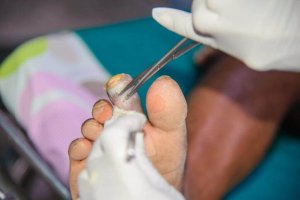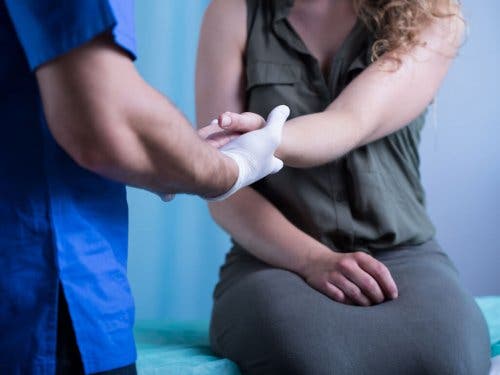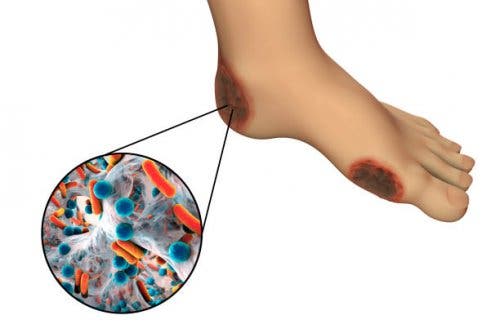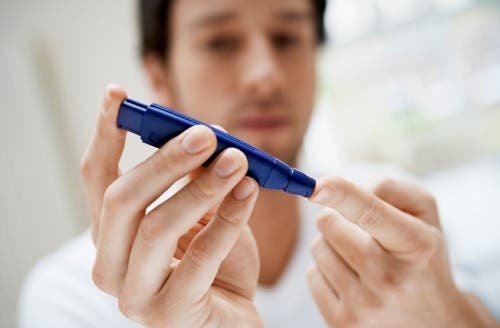Types of Gangrene: What It Is and What Causes It

Gangrene is a serious disease that affects tissue, causing it to die (necrosis). The bacteria known as Clostridium perfringens is normally what causes it. However, there are other reasons a person might be affected by this problem. In this article, we’ll discuss the different types of gangrene that exist, and how they develop.
Additionally, we’ll talk about the symptoms of this disease and the importance of going to a doctor as soon as possible to avoid the situation becoming serious, and even causing death.
Types of gangrene
1. Dry gangrene
This first type of gangrene is caused, as indicated in the study Mionecrosis due to Clostridium: a disease of all times, when the arteries and tissue are blocked, preventing blood flow from reaching the affected tissue.
One of the reasons this happens, in the majority of cases, is a vascular collapse that accompanies diabetes mellitus. However, it can also occur in people who have suffered an injury from freezing or arteriosclerosis. The treatment is vascular surgery, as long as it’s detected in time.
You might be interested in: The Causes of a Common Arterial Trunk
2. Wet gangrene

Unlike the previous case, in this case it’s caused by contamination of a wound, either by dirt or other elements. This type of gangrene is deadly, which is why you need to treat it with antibiotics and emergency surgery. It normally affects the mouth, intestine, lungs, vulva, and other mucous membranes in the body.
3. Gas gangrene
Gas gangrene is characterized by its rapid progression, as indicated in the article Gas Gangrene: Presentation of a Case. As the article notes, traumatic wounds are the most common cause.
It evolves through the appearance of edema (swelling) that makes blood circulation difficult. The only way to combat it is by removing the damaged tissue as soon as possible.
4. Fournier’s gangrene
This final type of gangrene that we’re going to describe has a notorious characteristic, which is that it normally affects the perineum and surrounding area, both in men and women. Fortunately, it’s not a very common type. However, when it happens, it tends to appear in older people.
Fournier’s gangrene is very serious and normally needs invasive surgery that could require amputation of the genitals. In some cases, once surgeons fix it, they do reconstructive surgery with skin grafts.
Symptoms

Now that we’ve seen some of the most common types of gangrene, as well as possible treatments, it’s important to describe the most important aspect: the symptoms.
Knowing what to look for and when to seek emergency medical attention will help you, if you have gas gangrene, to avoid fatal consequences. Remember that gangrene turns into necrosis and this, if you don’t fix it, can end in death. The following are common symptoms:
- Changes in skin color. It can turn purple, brown, or red.
- Swelling or edema. Sometimes it can be accompanied by blistering.
- Very intense pain in the area where the disease appeared.
- A foul odor that indicates that the tissue is rotting (the start of necrosis).
- Fever, which indicates that there’s an infection.
Another symptom you can feel is malaise. If the gangrene evolves quickly, your skin can start to fall off. Without a doubt, it’s important if you notice some of these symptoms that you go and see a doctor immediately. That way you can get treatment and avoid amputation or even death.
Discover: How Tobacco Affects the Skin
Risk groups

It’s important to know that the groups that have a higher risk of suffering from this disease are people with diabetes, some type of vascular disease, or cancer.
These people, for any wound or lesion, like the ones mentioned before, should see a doctor for proper cleaning and follow up.
We hope this article helped you to get rid of any doubts you had about this disease, as well as teaching you about the different types, and other useful information.
https://mejorconsalud.as.com/la-gangrena-que-es-y-cuales-son-sus-causas/
All cited sources were thoroughly reviewed by our team to ensure their quality, reliability, currency, and validity. The bibliography of this article was considered reliable and of academic or scientific accuracy.
- Fuentes Valdés, Edelberto, Núñez Roca, Ariel, Kapaxi Andrade, Josina, & Fernandes da Cunha, Yacira. (2013). Gangrena de Fournier. Revista Cubana de Cirugía, 52(2), 91-100.
- García-Sánchez, J. E., Fresnadillo, M. J., & García-Sánchez, E. (2010). Nuevas bacterias anaerobias implicadas en enfermedades infecciosas humanas. Enfermedades Infecciosas y Microbiologia Clinica, 28(3), 173-184.
- GAUGES, H., & ROSENBLUT, E. (1957). Gangrena de las extremidades en niños recién nacidos. Revista chilena de pediatría, 28(1), 29-33.
- Pila Pérez, Rafael, Pila Peláez, Rafael, Guerra Rodríguez, Carmen, del Risco Turiño, Carlos, & Ferrer Padrón, Alejandro. (2002). Trastornos vasculares y cáncer. Comunicación de un caso y revisión de la literatura. Revista Archivo Médico de Camagüey, 6(3), 294-300.
- Suárez Lescay, Celso, & Infante Carbonell, María Cristina. (2011). Mionecrosis por clostridio: una enfermedad de todos los tiempos. MEDISAN, 15(1), 112-124.
This text is provided for informational purposes only and does not replace consultation with a professional. If in doubt, consult your specialist.








